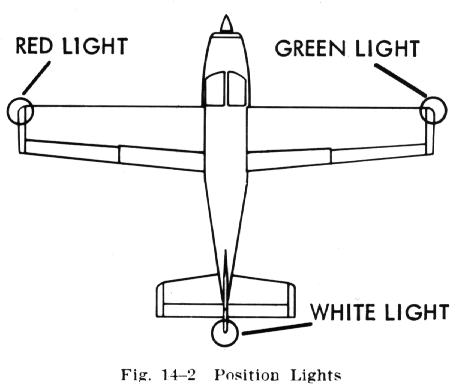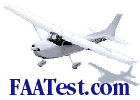| Airplane Lighting and Equipment
Federal Aviation Regulations, Part 91, specify certain minimum airplane equipment required for night flight. This equipment includes instruments, lights, electrical energy source and spare fuses. Though not required by FAR Part 91, it is recommended, because of the limited outside visual references during night flight, that other flight instruments supplement those required. An operable attitude indicator, heading indicator, and sensitive altimeter are very valuable in controlling the airplane at night. Individual instrument lights along with adequate cockpit illumination, aid significantly in making night flying a safe and pleasurable operation. An anticollision light system, including a flashing or rotating beacon and position lights, is required airplane equipment. Airplane position lights are arranged similar to those of boats and ships. A red light is positioned on the left wingtip, a green light on the right wingtip, and a white light on the tail (Fig. 14-2). This arrangement provides a means by which pilots can determine the general direction of movement of other airplanes in flight just as sailors determine the direction of boats and ships. If both a red and green light of another airplane are observed, the airplane would be flying in a general direction toward the pilot seeing the lights, and could be on a collision course. If only a red light is seen, the airplane is traveling from right to left in relation to the observing pilot. On the other hand, if only a green light is observed, the airplane is traveling from left to right. 
Landing lights are not only useful for taxi, takeoffs, and landings, but they also provide a means by which your airplane can be seen by other pilots during flight. FAA has initiated a voluntary pilot safety program. "Operation Lights On" to enhance the "see and be seen" concept of averting collisions both in the air and on the ground, and to reduce bird strikes. All pilots are encouraged to turn on their landing lights when operating within 10 miles of any airport (day and night), in conditions of reduced visibility and in area where flocks of birds may be expected. Although turning on aircraft lights does enhance the "see and be seen" concept, pilots should not become complacent about keeping a sharp lookout for other aircraft. At times aircraft lights blend in with stars in the sky or the lights of the cities and go unnoticed unless a conscious effort is made to distinguish them from other lights. With the increase in the number of radio navigation aids and
communication facilities, it is also recommended that the airplane be equipped
with at least one radio navigation receiver and indicator, and two way radio
communication capability.
|
